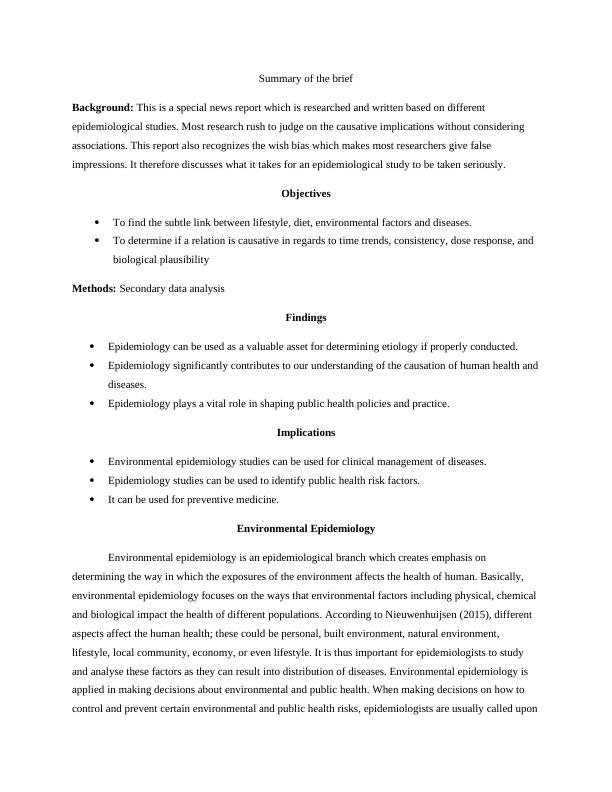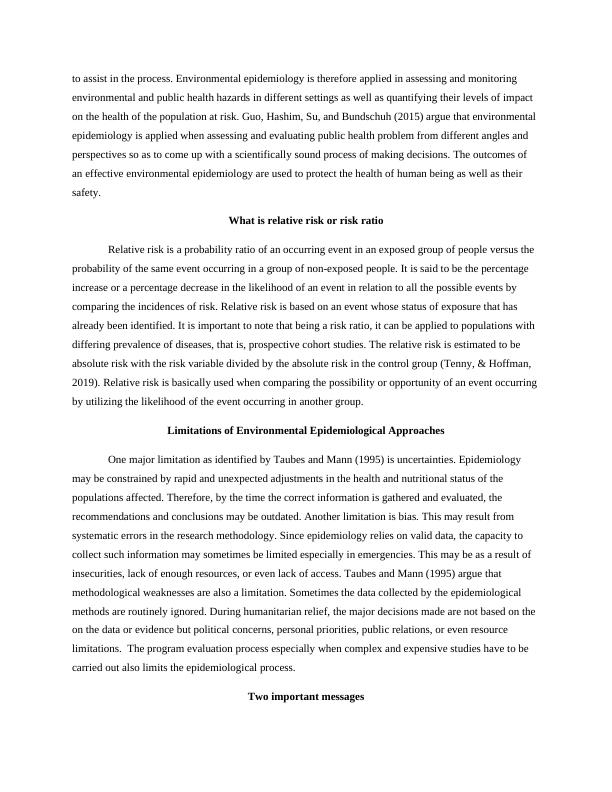Epidemiological Studies Report 2022
Added on 2022-10-19
4 Pages1116 Words11 Views
Summary of the brief
Background: This is a special news report which is researched and written based on different
epidemiological studies. Most research rush to judge on the causative implications without considering
associations. This report also recognizes the wish bias which makes most researchers give false
impressions. It therefore discusses what it takes for an epidemiological study to be taken seriously.
Objectives
To find the subtle link between lifestyle, diet, environmental factors and diseases.
To determine if a relation is causative in regards to time trends, consistency, dose response, and
biological plausibility
Methods: Secondary data analysis
Findings
Epidemiology can be used as a valuable asset for determining etiology if properly conducted.
Epidemiology significantly contributes to our understanding of the causation of human health and
diseases.
Epidemiology plays a vital role in shaping public health policies and practice.
Implications
Environmental epidemiology studies can be used for clinical management of diseases.
Epidemiology studies can be used to identify public health risk factors.
It can be used for preventive medicine.
Environmental Epidemiology
Environmental epidemiology is an epidemiological branch which creates emphasis on
determining the way in which the exposures of the environment affects the health of human. Basically,
environmental epidemiology focuses on the ways that environmental factors including physical, chemical
and biological impact the health of different populations. According to Nieuwenhuijsen (2015), different
aspects affect the human health; these could be personal, built environment, natural environment,
lifestyle, local community, economy, or even lifestyle. It is thus important for epidemiologists to study
and analyse these factors as they can result into distribution of diseases. Environmental epidemiology is
applied in making decisions about environmental and public health. When making decisions on how to
control and prevent certain environmental and public health risks, epidemiologists are usually called upon
Background: This is a special news report which is researched and written based on different
epidemiological studies. Most research rush to judge on the causative implications without considering
associations. This report also recognizes the wish bias which makes most researchers give false
impressions. It therefore discusses what it takes for an epidemiological study to be taken seriously.
Objectives
To find the subtle link between lifestyle, diet, environmental factors and diseases.
To determine if a relation is causative in regards to time trends, consistency, dose response, and
biological plausibility
Methods: Secondary data analysis
Findings
Epidemiology can be used as a valuable asset for determining etiology if properly conducted.
Epidemiology significantly contributes to our understanding of the causation of human health and
diseases.
Epidemiology plays a vital role in shaping public health policies and practice.
Implications
Environmental epidemiology studies can be used for clinical management of diseases.
Epidemiology studies can be used to identify public health risk factors.
It can be used for preventive medicine.
Environmental Epidemiology
Environmental epidemiology is an epidemiological branch which creates emphasis on
determining the way in which the exposures of the environment affects the health of human. Basically,
environmental epidemiology focuses on the ways that environmental factors including physical, chemical
and biological impact the health of different populations. According to Nieuwenhuijsen (2015), different
aspects affect the human health; these could be personal, built environment, natural environment,
lifestyle, local community, economy, or even lifestyle. It is thus important for epidemiologists to study
and analyse these factors as they can result into distribution of diseases. Environmental epidemiology is
applied in making decisions about environmental and public health. When making decisions on how to
control and prevent certain environmental and public health risks, epidemiologists are usually called upon

to assist in the process. Environmental epidemiology is therefore applied in assessing and monitoring
environmental and public health hazards in different settings as well as quantifying their levels of impact
on the health of the population at risk. Guo, Hashim, Su, and Bundschuh (2015) argue that environmental
epidemiology is applied when assessing and evaluating public health problem from different angles and
perspectives so as to come up with a scientifically sound process of making decisions. The outcomes of
an effective environmental epidemiology are used to protect the health of human being as well as their
safety.
What is relative risk or risk ratio
Relative risk is a probability ratio of an occurring event in an exposed group of people versus the
probability of the same event occurring in a group of non-exposed people. It is said to be the percentage
increase or a percentage decrease in the likelihood of an event in relation to all the possible events by
comparing the incidences of risk. Relative risk is based on an event whose status of exposure that has
already been identified. It is important to note that being a risk ratio, it can be applied to populations with
differing prevalence of diseases, that is, prospective cohort studies. The relative risk is estimated to be
absolute risk with the risk variable divided by the absolute risk in the control group (Tenny, & Hoffman,
2019). Relative risk is basically used when comparing the possibility or opportunity of an event occurring
by utilizing the likelihood of the event occurring in another group.
Limitations of Environmental Epidemiological Approaches
One major limitation as identified by Taubes and Mann (1995) is uncertainties. Epidemiology
may be constrained by rapid and unexpected adjustments in the health and nutritional status of the
populations affected. Therefore, by the time the correct information is gathered and evaluated, the
recommendations and conclusions may be outdated. Another limitation is bias. This may result from
systematic errors in the research methodology. Since epidemiology relies on valid data, the capacity to
collect such information may sometimes be limited especially in emergencies. This may be as a result of
insecurities, lack of enough resources, or even lack of access. Taubes and Mann (1995) argue that
methodological weaknesses are also a limitation. Sometimes the data collected by the epidemiological
methods are routinely ignored. During humanitarian relief, the major decisions made are not based on the
on the data or evidence but political concerns, personal priorities, public relations, or even resource
limitations. The program evaluation process especially when complex and expensive studies have to be
carried out also limits the epidemiological process.
Two important messages
environmental and public health hazards in different settings as well as quantifying their levels of impact
on the health of the population at risk. Guo, Hashim, Su, and Bundschuh (2015) argue that environmental
epidemiology is applied when assessing and evaluating public health problem from different angles and
perspectives so as to come up with a scientifically sound process of making decisions. The outcomes of
an effective environmental epidemiology are used to protect the health of human being as well as their
safety.
What is relative risk or risk ratio
Relative risk is a probability ratio of an occurring event in an exposed group of people versus the
probability of the same event occurring in a group of non-exposed people. It is said to be the percentage
increase or a percentage decrease in the likelihood of an event in relation to all the possible events by
comparing the incidences of risk. Relative risk is based on an event whose status of exposure that has
already been identified. It is important to note that being a risk ratio, it can be applied to populations with
differing prevalence of diseases, that is, prospective cohort studies. The relative risk is estimated to be
absolute risk with the risk variable divided by the absolute risk in the control group (Tenny, & Hoffman,
2019). Relative risk is basically used when comparing the possibility or opportunity of an event occurring
by utilizing the likelihood of the event occurring in another group.
Limitations of Environmental Epidemiological Approaches
One major limitation as identified by Taubes and Mann (1995) is uncertainties. Epidemiology
may be constrained by rapid and unexpected adjustments in the health and nutritional status of the
populations affected. Therefore, by the time the correct information is gathered and evaluated, the
recommendations and conclusions may be outdated. Another limitation is bias. This may result from
systematic errors in the research methodology. Since epidemiology relies on valid data, the capacity to
collect such information may sometimes be limited especially in emergencies. This may be as a result of
insecurities, lack of enough resources, or even lack of access. Taubes and Mann (1995) argue that
methodological weaknesses are also a limitation. Sometimes the data collected by the epidemiological
methods are routinely ignored. During humanitarian relief, the major decisions made are not based on the
on the data or evidence but political concerns, personal priorities, public relations, or even resource
limitations. The program evaluation process especially when complex and expensive studies have to be
carried out also limits the epidemiological process.
Two important messages

End of preview
Want to access all the pages? Upload your documents or become a member.
Related Documents
Importance of Incidence Rate Ratio in Public Health Studylg...
|6
|1303
|414
Concept of Epidemiology | Assignmentlg...
|7
|1486
|25
Environmental Health.lg...
|14
|464
|2
EPIDEMIOLOGY Name of the student: Name of the university: Authorlg...
|5
|900
|173
Practice Reflection on Biostatistics in Public Health Policy, Planning, and Managementlg...
|6
|1348
|156
Descriptive Epidemiologylg...
|8
|1978
|91
